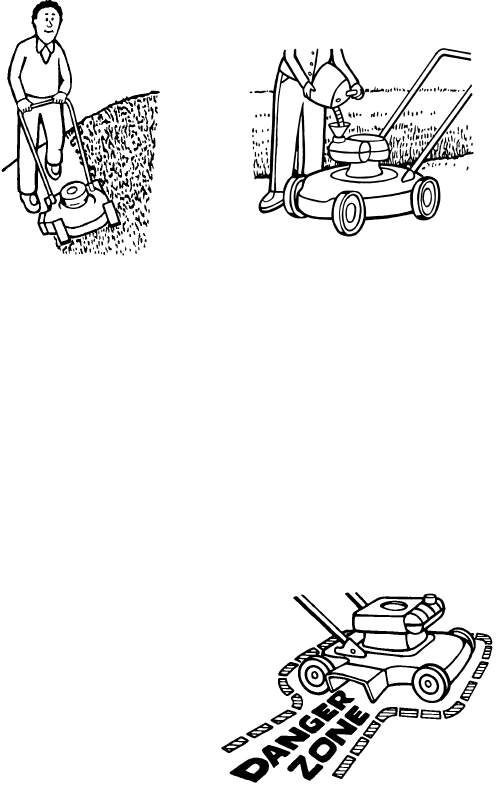
SAFE MOWING GUIDE
7
F-050406L
bruises, or even put out an eye. Often the per-
son hurt by a thrown object is a bystander such
as a child, another family member or a neigh-
bor. Keep people and pets completely away
from the mowing area. Direct the mower’s dis-
charge away from areas where people can be.
Planning your mowing pattern has a double
benefit. It can reduce chances of an injury and
make the clean up after mowing easier.
Are there ditches,
walls, or major in-
clines in the area to be
cut? Plan the mowing
pattern to avoid such
danger areas. In-
clines and rough ter-
rain must be mowed
carefully and some
areas must not be cut
with a mower at all.
With walk behind
equipment, mow
across the incline so
that if you or the mow-
er slip, you won’t run
into each other.
Never mow slopes greater than 15 degrees.
See the “Guide” in the back of this Instruction
Book to check any slopes.
Ready to start cutting? Not yet. Be sure the
mower has been fully assembled according to
directions in the Instruction Book. Even if as-
sembly was done by a lawn and garden shop
or the store where the unit was purchased, it
must be checked. Are all nuts, bolts and
screws tight? Does the engine have oil? These
items must be checked periodically throughout
the life of the mower.
Your mower has a gasoline engine. Gas is
dangerous. Store fuel only in a approved gas
container. Do not store large amounts of gas.
Put out all cigarettes, pipes and cigars before
working with gasoline. Store fuel and the mow-
er itself in a well ventilated area away from any
possible source of ignition such a pilot light on
a furnace. If the mower is to be stored for an ex-
tended time, remove the gas from the tank.
This minimizes the chance of a fire and keeps
the tank clear of deposits and old gasoline,
thus improving mower performance. Move the
mower outside before adding gasoline. Use a
funnel and wipe up any spilled fuel before start-
ing. Remember, gasoline expands when
heated so leave some expansion room. Also,
most mower gas caps are vented to allow for
expansion. Always use the proper cap. People
are needlessly burned by fires, hurt in explo-
sions, mowers and other property are dam-
aged because of failure to follow basic safety
rules related to gasoline and fueling.
Never add gasoline to an engine that is running
or that is hot from recent use, this can cause an
accident. Remove dry grass and other debris
from the mower. Keeping the mower clean will
improve the performance, help the engine stay
cooler, extend the life of moving parts, and
minimize the danger of fire. People get burned
working with and around their mowers for oth-
er reasons than fire and explosions. It takes
only a few seconds of operation for the engine
and the muffler to become hot. Do not touch
these parts when the mower is running. Stop
the engine and let it cool down before servicing
the mower. Remember, exhaust fumes can be
dangerous. Never operate the engine indoors
or in an enclosed area.
Getting a new mower can be a big event for a
family. Let family members satisfy their curios-
ity about the mower and at the same time, tell
them about its dangers. Remember, a mower
is not a toy and is not for use by children or any-
one lacking in age, strength or experience.
As with any power equipment, a mower can be
dangerous if not assembled, misused, or not
properly maintained. The most important rule
is to always use good judgement and common
sense.
Your mower will cut thick grass and heavy
plant stems with ease. Fingers and toes are no
more resistant to the mower’s blade. Many
people are injured because they “forgot” and
reached into the discharge chute. Always treat
your lawn mower as if the blade is rotating.
Never perform any service or try to make any
adjustment,except carburetor, while the en-
gine is running.
Use only accessories suited for your mower.
Use of improper accessories can reduce the
safety designed into both the mower and the
accessory, it can even damage the unit. Read
and follow the instructions which come with the
accessory and the mower.


















